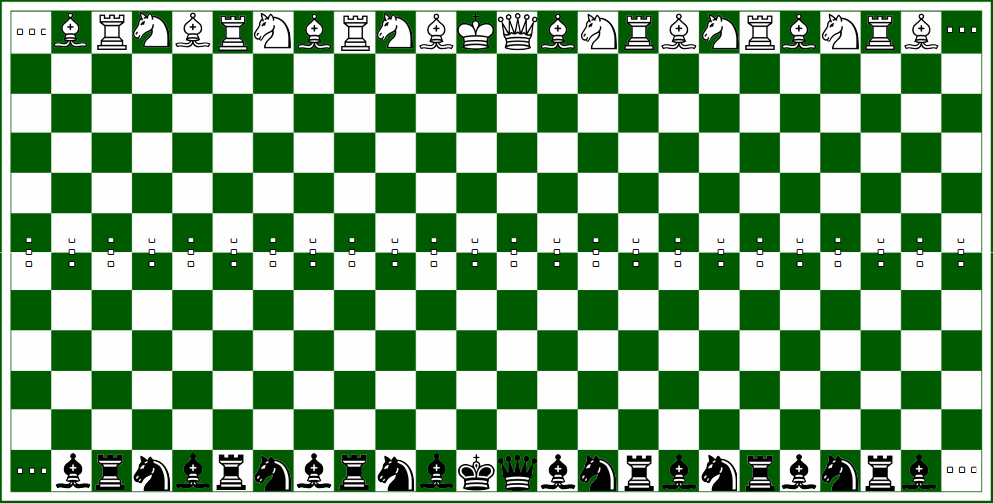In infinite chess, your king will always be in the sights of a bishop
Think of a conventional chess except that it has no pawns and infinite horizontal and vertical dimensions.
But in the face of so many types of infinities, let’s say that in the horizontal sense they are equivalent to the Integer numbers, with the black king’s position as 0. To the right of him (queen’s sense) we have the positive Integer numbers, and to the left with black king the negative integers.
In the vertical sense, we will also use the whole numbers as a model, imagine the black king line as -1, and all the lines in front of that line as -2, -3, -4, … up to -∞. Similarly, the white king is on line 1, and all lines in front of him as 2, 3, 4, …, up to ∞.
So for example, if we move the black king in a square, it will occupy the position {horizontal (0), vertical (-1)}. If we move the white king two squares, it will occupy the {horizontal (0), vertical (2)} position.
Thus, we can describe any position in relation to white pieces or black pieces.
Let’s assume that each player has only one king and one queen, but that the bishop-knight-tower pattern is repeated in the infinite horizontal squares on the right and left, as shown in the figure below.

As the houses follow the black-house and white-house pattern, and we have that the set is vertically limited, the number of vertical houses is given by 2N where N is as large a Natural number as you want.
Considering the usual rules of chess, we have that it is impossible for horses and kings to reach positions on the other side. For example, the white king moving forward by K movements, will be at the maximum in the vertical position (K + 1), for any K we will always be able to take a larger N, therefore, cross the vertical “divider” of the board for these pieces is impossible in a finite number of movements.
On the other hand, towers, bishops and queens can move “any” number of pieces, let us call X, so for any N we can take X> (2N – c), where c is a Natural number. In this way, these pieces can cross the vertical partition of the board.
For example, imagine the black king’s rook located in the {horizontal (4), vertical (-1)} position;
We move the tower {horizontal (4), vertical (-1)} – moves to – {horizontal (4), vertical (-10)};
We move the tower {horizontal (4), vertical (-10)} – moves to – {horizontal (6), vertical (-10)};
- Now that we have the black tower in front of a white horse *
We move the tower {horizontal (6), vertical (-10)} – moves to {horizontal (6), vertical (1)}. - That is, the black tower, advanced X squares vertically, where X is equal to (2N – 10) * eliminating the white horse.
So far so good, we can imagine some moves vertically and horizontally. However, what to think of the bishops? If a bishop moves X squares diagonally, where does he end up?
For example, suppose the white king is in the {horizontal (0), vertical (1)} position, is the white king being threatened by a black bishop? We have 3 options to analyze:
- No bishop threatens the king;
- A bishop threatens the king;
- Two bishops threaten the king;
Assuming that no bishop is in the horizontal (2N) or (-2N) position. But the positions of the bishops are given by:
… -18, -15, -12, -9, -6, -3, 2, 5, 8, 11, 14, 17…
Analyzing these positions in absolute value, we have:
2, 3, 5, 6, 8, 9, 11, 12, 14, 15, 17, 18,…
Expressing these positions in algebraic form, the horizontal positions in module greater than 0 where we will have no bishop will be given by (3B-2), where B is a Natural number greater than 0.
So, for 2N vertical houses where N is a Natural, we can rewrite it as 2N = 3B-2, so when N = (3B-2) / 2, no bishop will be threatening the white king.
But since N is any natural, then there must be N such that N ≠ (3B-2) / 2. Thus, we rule out the first option (no bishop threatens the king).
Now if we assume that two bishops threaten the king, then N = (3B-1) / 2 and N = 3B / 2 for any N. If that were true, then:
(3B-1) / 2 = 3B / 2,
but that would imply that,
3B – 1 = 3B
but we would arrive that
-1 = 0
In other words, this alternative would also be absurd.
Finally, we arrive that regardless of the value of N, there will be a bishop pointing to the white king.
Even more frighteningly, there will always be a bishop pointing at the white king. For even if that specific bishop attacks and dies, we can always choose another bishop whose N = (3B-1) / 2 or N = 3B / 2, so that he is pointing exactly at the white king. This is because N is any Natural as big as we want.
Cover image adapted from Ramon Perucho from Pixabay

